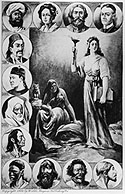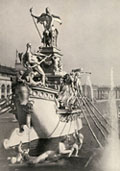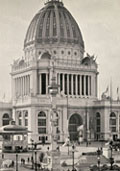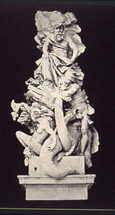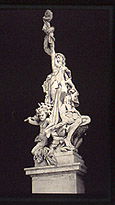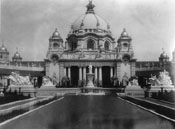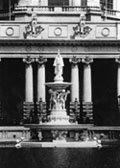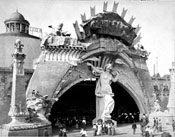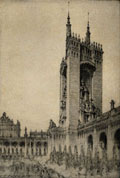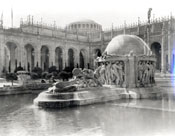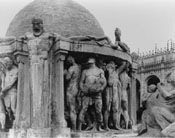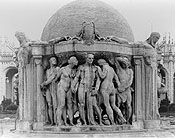The browser will either open the file, download it, or display a dialog.
|
|
Progress and Evolution at the U. S. World's Fairs, 1893–1915 |
|||||
|
The "inspiring story of Nature's beneficence and Man's progress" was the central narrative of the classicizing world's fairs that flourished in the United States between 1893 and 1915.1 These spectacles were a nearly constant presence on the national cultural landscape during this period; at least one was being held or planned at every moment, and the appetite for them remained undiminished by familiarity. Pitting nations against one another for prestige and markets in every field of production, the fairs elicited from visitors amazement and awe—infused with pride, identification, and assent—before the stunning achievements gathered for display. | |||||
| For sculptors charged with preparing monuments for key sites on the fairgrounds, effective allegories of progress posed the most pressing and difficult challenges. Each fair contained multiple and varied efforts to represent the progress of "man," usually construed as a particular configuration of nationality, race, and gender. These efforts conjoined classical forms—triumphal arches, columns of progress, elaborately sculpted fountains—with recent accounts of material and cultural history. The iconography of progress pressured traditional academic artists to represent modernity as an improvement on the past and to render it in ways that would elicit affirmation and support from popular audiences. In other words, such commissions complicated academicism's commitment to tradition by stipulating a subject better suited to modernism. | ||||||
| Theories of evolution were so often enfolded into the expositions' representations of progress that the two concepts were fundamentally elided.2 This elision required a particular kind of evolutionary theory—specifically, a progressive and hopeful sort, such as that associated with the writings of Herbert Spencer. As Kathleen Pyne has convincingly argued, Spencer's views were favored among American elites at the turn of the century, because "his thought buttressed [their] inherited ideology . . . in both its socioeconomic aspects and its religiophilosophical aspects."3 Spencer legitimated the identification of evolution with progress within an unreconstructed Protestant world view. His theories are implicit in many late-nineteenth-century works of art and decorative programs advocating social refinement through aesthetic sensitivity. In the decorations designed for buildings and grounds at American expositions, such objectives merged with the celebration of national progress and providential mission, to which Spencer's views were also congenial. | ||||||
| Although Charles Darwin's competing theory contradicted cherished religious and philosophical beliefs by robbing nature of divine purpose and humankind of centrality, it too had attractive aspects. Its unflinching commitment to science was one source of appeal, and its basic principles—competition and survival of the fittest, construed as fundamental laws of nature—lent themselves to justification of capitalism and social hierarchy. The explanation I have cited for Spencer's appeal to the northeastern elites—reinforcement of deep-rooted belief systems—also fits Darwin's theory, although its repugnant aspects would have made complete and open endorsement unlikely. Nonetheless, this logic suggests that a furtive or repressed Darwinism might lurk in what may seem the most unlikely of places: the representations of progress on the exposition fairgrounds. This paper broaches that question by examining surprising elements and discordant notes in some of the allegories of progress and evolution most prominent at the American fairs. My case studies, mostly sculptural, drawn from the expositions of 1893 (Chicago), 1901 (Buffalo), 1904 (St. Louis), and 1915 (San Francisco), represent varied and changing approaches to the representation of progress. | ||||||
|
|
||||||
| The message of evolutionary progress was to be found throughout these fairgrounds in ubiquitous juxtapositions of the primitive and the modern. The fairs celebrated the ascension of "civilized" power over nature and "primitive" peoples, and this contrast was staged in every field of endeavor.4 Frederic Ward Putnam, director of the Smithsonian exhibit at the Chicago fair, introduced his displays this way: "The first rude attempts in human art and industry are here illustrated, and form a striking contrast to the splendors of modern civilization so lavishly displayed on every side."5 | ||||||
| Sometimes the organization of exhibits implied a hierarchy of races and nationalities, in which each represented a stage in the evolutionary process, as on the midway in Chicago. An illustration published to accompany the anthropology exhibits in St. Louis spells out the prevailing wisdom concerning the sequence.6 (fig. 1) Chronology is established by prehistoric man's presence at the beginning, but he yields to a series of living peoples: Bushman, Ainu, Negro, American Indian, Arab, and on to Americo-European man at the pinnacle. | ||||||
|
Most of the principal sculptural monuments figured progress in more abstract ways. The standard was set at the World's Columbian Exposition in Chicago in 1893, where several allegories of progress were clustered at one end of the Court of Honor. In the Grand Basin, Frederick MacMonnies's monumental Columbian Fountain (fig. 2) was the most prominent, showing American progress as an advancing barge of state. ("America" was to be understood as coterminous with the host nation.) A figure of Columbia sat atop the barge, with Father Time at the stern handling the rudder and eight oarswomen, embodying the arts and sciences and assisted by natural forces in the form of seahorses and riders, supplying propulsion. At the bow Fame trumpeted the rapid advance of this busy group. The upbeat idea of national progress figured here is compromised by the unseaworthy character of the tottering, rococo vessel and by the ominous conflation of Father Time's scythe with the ship's rudder. Although Stanford White voiced concern regarding the sketches for the fountain—"I am a little bothered about the scythe that Time is steering with"—MacMonnies was evidently untroubled by the implication of death in the nation's direction and in its wake.7 | |||||
| Just behind the Columbian Fountain stood the Administration building (fig. 3), where the fair's executive and administrative offices were housed. Designed as a showpiece and set at the main entrance from the train station to the Court of Honor, this building was made a pavilion of progress through its artistic embellishment. Its bronze dome was produced at great expense, and its lavish sculpted and painted decorations were the principal attractions for visitors to the building. | ||||||
| Karl Bitter designed monumental sculptural groups, about thirty-four feet high, for the four entrances of this building. Bitter was the preeminent figure in exposition sculpture in the U. S. during this period. He was a principal contributor to all the classical fairs as well as director of sculpture for those in Buffalo, St. Louis, and San Francisco, although he died unexpectedly just before the opening of the latter. In Chicago, Bitter produced paired allegories of the four natural elements to flank each entrance to the Administration Building. On one side of each entrance he portrayed an element in its raw, "uncontrolled" state; on the other he represented the "controlled" element, put to the service of enterprising humans. One pair, Earth Uncontrolled and Earth Controlled (figs. 4 and 5), is enough to illustrate the idea. To paraphrase the guidebook explanations, Earth in its natural state is portrayed as an old but powerful man, resting his fist on his sturdy knee and peering forward; he is intended to evoke a mountain. Beneath this figure a man sits atop a mammoth's head, leaning on a broken tusk and looking at his wife, who is wrestling with a monkey for fruit. "This is to represent the earth in its original relations to man, when he had to live like and contend with the animals." In Earth Controlled, the stately figure of a woman is proudly lifting in the air a crown and precious stones, while the other hand drapes her garments in rich folds. "She shows that man forced from the earth all that was exquisite and valuable to him."8 Beneath her is a strong man breaking a rock to get at the raw materials which will be transformed through manufacturing into the objects the woman holds in her hand. At her right side is a youth, who with a smile, carries upon his shoulder a basketful of fruit and grain. | ||||||
|
|
||||||
| The humor, intentional and unintentional, does little to mitigate the crudeness of these works. The gleeful aggression with which the human figures appropriate and pillage the resources of the earth in these sculptures may strike us as horrifying or quaint; but here is material progress in its simplest and clearest terms. The tradition of the four elements has been refurbished for the modern exposition through combination with the latter's characteristic juxtaposition of primitive and modern. Progress here is something produced in simple binary oppositions. It is directed by humans for their own benefit. "Man" is an uncomplicated creature in single-minded pursuit of satisfaction of his material needs and wants, and Bitter's juxtapositions conjure a fantasy of complete mastery of nature. The debased baroque classicism of the sculpture suits this message insofar as the expositions construed classicism as the style of progress; it epitomized artistic development by simple opposition to the primitive arts displayed throughout the fairgrounds. All neoclassical art drew meaning from this habitual juxtaposition and conjured the primitive as implicit guarantee of its own progressive, aesthetic achievement. By this logic neoclassicism laid claim to being the artistic style best suited to the representation of progress. At the same time it enveloped modernity in a reassuring, stable form. | ||||||
|
Man, the progressor, takes on more complex features eight years later at the Pan-American Exposition in Buffalo. Now the exposition's director of sculpture, Bitter was one of the planners of the sculptural group arrayed in the large esplanade and reflecting pool before the U.S. Government Building. (fig. 6) The guidebooks explained that the theme of this collection of works was "The Progress of Man and the Development of his Institutions." Bitter and John Carrère of the architectural firm Carrère and Hastings designed the scheme illustrating human progress through a three-stage sequence of Ages—from Savage to Despotic to Enlightenment. This sequence was familiar in the nineteenth century and referred back to Enlightenment authors' description of their own time as a third age following upon Monarchic and Despotic precursors. | |||||
| Six figure groups were paired on opposite sides of the long reflecting pool. At the end nearest the Government Building stood two symbolizing the Savage Age, both by John Boyle. In one a group of Indians was shown in an attitude of attack; in the other, a band of Goths carried off captive women. The Despotic Age by Isidore Konti (the companion group was by H. A. McNeil) showed a despot forcing his subjects to pull the chariot of state. Cruelty whips them as they struggle. Relief for mankind comes only with the Age of Enlightenment. These groups, both by Herbert Adams, show peace, social order, and learning bringing security, happiness, and knowledge to the family. The artistic and ideological climaxes of the series were confusingly out of synch: Konti's Despotic Age was by far the most dynamic and popular sculpture of the group. | ||||||
|
The agent of the series' three-stage progression to the magnificently harmonious present was depicted in The Fountain of Man by sculptor Charles Grafly. (fig. 7) Rising to a height of fifty-three feet, it was set at the end of the pool, directly in front of the entrance to the U. S. Government Building, between the Savage Age groups. At the top of the fountain stood Man the Mysterious, a figure "emblematic of the two natures of man," according to guidebooks. It consisted of two figures joined back to back, the junction between the stiffly frontal bodies concealed by the drapery enshrouding them, which parted just enough to reveal faces looking in opposite directions. Snug helmets connected by a slender arch framed these two faces. The rigid stance, symmetry, and the pegs held in all four hands secured reference to ancient Egyptian sculptures and their orientalist mystery. The rest of the fountain further elaborated the fragmentation of the self symbolized by the double figure. Below it and separated by a basin, a ring of five figures representing the senses stepped in unison with hands joined. At a lower level, beneath a second, larger basin, several pairings of male and female figures representing the virtues and vices were shown crouching together, bumping and jostling one another.9 | |||||
| Such an ambiguous image of man featured so prominently at a celebratory international exposition is odd, not least because of its anti-evolutionary and anti-progressive implications. Its symbolist model of man, indebted to the work of George Gray Barnard and others, featured doubling, division, conflict, unclear motivations, and indistinct elements.10 The character of the division of self it portrayed was ambiguous: simultaneously good and evil, material and spiritual, dionysian and apollonian, and "dipsychic."11 Such an image of man undermined any model of progress in which man is an effective agent generating steady improvement. That is to say, the message conveyed in the surrounding sculptures on the esplanade was undermined by the fountain at their heart. Moreover, the sculpture's Egyptian style challenged any assumption that artistic evolution had culminated in classicism. Grafly's fountain is more than a crack in the edifice of the simply celebratory view of man the progressor; it is a striking sign of things to come. | ||||||
|
One exhibit at St. Louis's 1904 Louisiana Purchase Exposition demands attention in this context, although it was not an allegorical sculpture. In contrast to the fairground's monumental sculpture, which featured all too familiar juxtapositions of the exhausted Indian race and the vital, westward moving Euroamerican nation, an inventive attraction on the midway was taking a more ambitious and imaginative approach to the issues of progress and evolution, and it was drawing large crowds. |
|||||
| Creation (fig. 8) was produced by Henry Roltair, a popular and successful dime museum illusionist who gradually expanded his illusions into sensational world's fair and carnival spectacles. His masterpiece was undoubtedly Creation, the ambitions of which were unprecedented in the genre of spectacular amusements: to represent "the formation of the earth and its inhabitants, evolved for the benefit of all people." The show began with a boat trip through dark caves and winding canals, during which "scenes illustrative of the beginning and end of all things" flashed briefly into view. Among the images conjured in the canals were the Grand Canyon, "with its legible imprints of the ages," and Yosemite, showing "the grandeur of the forest primeval." Scenes of primitive nature gave way to scenes of primitive life in the form of early fauna and reptiles, primitive habitations, scenes of prehistoric man at a stage "just one remove from the animal," and so on, to the ancient cities of the Egyptians and the Israelites. "The advancement of man is conveyed in the increasing splendor of these cities." The scope of this opening scenario was more ambitious than any contemporary mural painting in the established genres of the "Evolution of Civilization" or the "Progress of Man." | ||||||
| The boat landed, and visitors were directed to another cave in which some of Roltair's renowned illusions were installed: first, a living half-woman on a pedestal, then the speaking head of a Negro man set atop the two prongs of a pitchfork. Visitors were "prepared by these and several minor illusions for the grand climax of this illusionary world."12 Climbing a dark staircase, they entered the viewing platform of a vast cyclorama open to the sky showing scenes of great cities of the world, including Venice and Rome. Boats filled with musicians, gondoliers, and passengers circulated in the canal that separated the platform from the encircling painted wall. Some real ducks swam around in these waters. The viewing stand comprised concentric walkways, one stationary and one moving, which allowed viewers to see the entire panorama by stepping on and off the moving platform, although this produced a slightly dizzying effect. Only after leaving the platform and climbing another stairway that led into one of the boats did visitors realize that the boats were fixed in place. What had seemed stationary was actually moving, and vice versa. The painted panorama and the viewing platform (with the exception of one of the walkways) were rotating constantly, their machinery silenced by the water. | ||||||
| Now thoroughly disoriented by this panoramic illusion—which provoked some commentators to call it "the most perfect illusion I have ever seen," an illusion so complete that it "leaves the brain in a whirl of delight and doubt"—visitors were led to an amphitheater for still another climax of the exhibit.13 Here they encountered the spectacle of biblical creation. With a choir of voices singing the lines of Genesis—"let there be light," etc.—"strangely tinted clouds rush with bewildering rapidity across the dome. The earth moves out of chaos." As the choir chants "waters cover the earth," "islands arise as if by magic from the seas. Lightnings fork in the heavens—not flash, but spring down out of the sky in blinding strokes as vivid as in any storm on the Hudson. A volcano opens its crater with a thunderous explosion and sweep of gases like unto Mount Pelee. Molten rivers rush down its sides." | ||||||
| For each of the seven days of creation a different scenic backdrop was wheeled into place on the stage and new pyrotechnic, projective, and other spectacular effects activated. Finally, on the last day, all is calm, forests and animal life appear, and Adam is revealed, seated on a rock. Joined by Eve, he holds out his arms to her, and the show is over. "'This way out,' calls a stentorian voice. And the audience wakes up to grope its way forth into the noise and bustle and lights of the Pike." Creation left viewers disoriented and doubting their perceptions of up and down, moving and static, real and illusory as they rejoined the frenetic world outside. | ||||||
| Although the final segment was framed in terms of the biblical script, Roltair's booklet for the show made clear that he was striving to reconcile that account with the latest scientific theories. "The explanation of the phenomena of past ages must be sought for in the facts and laws of nature as they come under direct observation." Was there an implicit criticism of the conventions of sculptural allegories in Roltair's comment on the quaintness of the motif of the four elements? After all, he pointed out, modern science had revealed that there were dozens. Ideas drawn from theories of evolution, geological history, and entropy reshaped the narrative of Genesis. Although Darwinian competition was not mentioned per se, human history was by no means simply progressive. Roltair described a future in which all humans had perished as the energy of the sun diminished. | ||||||
| Roltair's ambitious history of the world and humankind was based on a difficult reconciliation of biblical and scientific revelations, and his strategy was to set the disagreements in a realm of disorienting illusions. When all perception and cognition are experienced as unreliable, the conflicts of science and religion dissolve into the unity of the spectacle. | ||||||
| Official exposition sculpture did not devise a view of the human past and future as dark and complex as Creation's until 1915. The Panama-Pacific Exposition in San Francisco featured one of the most peculiar allegories of man and his development produced for any fair: Robert Aitken's Fountain of the Earth. To be sure its strange, grim vision was counterbalanced by the fair's Column of Progress and other simpler and more traditional monuments, but its message must have been all the more disturbing for appearing among them in the heart of the exposition. | ||||||
|
The fountain was set in architect Louis Christian Mullgardt's Court of the Ages (fig. 9), one of the several courts that organized the San Francisco fairgrounds. Mullgardt conceived this court as "a sermon in stone on the evolution of life."14 In the words of one interpreter, "the entire evolution of Nature has been symbolized."15 Mullgardt's concept allied the Enlightenment model of a succession of historical ages with evolutionary theory. It was as if these two models of progress were plotted alongside one another on a vertical time-line throughout the court. The ages now were reconceived to begin with the formation of primitive flora and fauna; this was followed by the period of early sea life, then the diversification of life in the stone age, and finally the period of human struggle for emancipation. | |||||
|
Familiar allegorical figure groups, carved by sculptor Chester Beach, appeared on the court's Tower of the Ages.
The allegories of the ages occupy only about a third of the vertical time line that rises to higher levels of perfection. Below them are the levels represented in the arcade, which was decorated with plant and animal motifs that mark the earlier stages of evolution. On the lowest level, in Mullgardt's words:
Higher plant and animal forms were used for decoration at the higher level of the tower. "A gradual development to the higher forms of plant life is expressed upward in the altar tower, the conventionalized lily petal being the highest form."18 The cycle of figures around the top of the arcade apparently stood outside the time line, since they seemed to belong lower down. Three figures were repeated: "a hunter dragging a deer, a woman with her offspring on her shoulder, and a primitive man feeding a pelican."19 |
||||||
| Plants, animals, and humans all evolved in concert in this decorative program. Humankind's progress toward knowledge and a more perfect social order was part and parcel of a general development toward more complex forms of plant and animal life. So in the court overall evolution was given a progressive and optimistic spin. | ||||||
| Situated at the center of the Court of the Ages was Robert Aitken's Fountain of the Earth (fig. 10), an allegorical narrative of human life and history. It was one of the sculptural centerpieces of the San Francisco Fair, described in detail in guidebooks and featured in magazine articles.20 This fountain brought Aitken to national prominence that lasted at least to 1920.21 | ||||||
|
Aitkin's sculpture told a story beginning with a prologue, on a sort of peninsula extending from the main structure, which was built around a globe suggesting the earth.22 The monumental hand of Destiny gives life, in a gesture obviously evocative of the Sistine Ceiling Creation of Adam, to a woman who emerges from Prenatal Sleep in a cinematic three-stage awakening. The woman is joined by a man, reversing the gender sequence of Genesis, and together they proffer a child who represents the Beginning of Things. |
||||||
| From here across a small spatial gap, representing a temporal break of unknown duration, the story moved to the frieze of life-sized figures surrounding the globe in four panels. At the center of the first panel, Vanity gazes into her mirror and primps her hair. To her right, primitive man and woman brutishly trudge toward an unknown future bearing their children in their arms. (fig. 11) | ||||||
| In the second panel, titled Natural Selection, an Adonis embodying courage and beauty and sporting wings on his head attracts the attention of two women, which incites the jealousy and humiliation of the rejected men flanking the group. (fig. 12) Guidebooks and commentators noted that this panel showed woman to be the cause of the "awakening of the war spirit."23 In the third panel, Survival of the Fittest, this tension erupts into conflict as two men begin to fight. Animal appetites and instincts are the premier causes of conflict in the world. In the fourth panel, Lesson of Life, a young man and woman ignore the counsel and restraint of elders and parents as they are drawn to one another. The significance of this panel seems to be that the young refuse to learn from the lessons of the past. So much for progress. But if the lesson in question is to resist sexual attractions, the future of the species may be at risk. | ||||||
| As it turns out, the future is none too promising anyway. The narrative proceeds back to the right side of the first panel (fig. 10), where Lust is figured by an aggressive male and a resistant female. The closing acts are staged on the peninsula. Greed hoards some unspecified bundle, carrying it away from the world. Faith is represented as a patriarch on his knees, holding out to a woman a scarab symbolizing renewed life and hope in immortality. And finally, Sorrow and Sleep are drawn back into oblivion by the other hand of Destiny, which returns us to the primordial muck. | ||||||
| The only hint of escape from this cycle is indicated in faith's hope for another, supernatural life, which makes this fountain literally a sermon in stone. As for earthly life, there is no window for virtue or chance. There are no winners, fit or otherwise. The pessimism of this particular reconciliation of Darwinism and Christianity must have been conditioned by the outbreak of World War I, which spoiled San Francisco's celebration of the completion of the Panama Canal. Competition and conflict are naturalized in this sculpture to the extent that they are shown to be inescapable, but Darwin's fundamental principles of nature are reconfigured as cardinal sins resulting from the irrepressible pride and greed of humans. | ||||||
| Darwinism resisted teleology, but here it was turned back on itself to form a closed circle. This grim circularity may have related to biblical dogma regarding the wages of original sin or the return of dust to dust—alternatives to Genesis as focal points for reconciliation with evolution. Or it may have reached back to the sort of pessimistic cyclical theory of history in fashion a century earlier, when Thomas Cole painted his Course of Empire.24 Aitken reinforced stylistically this message of cyclicality. He separated the panels of the main structure with figures of Hermes (fig. 11), their arms outstretched over the lintels and their hands holding the beginnings of life in the form of serpents, crustaceans, and other rude primeval beasts, the mouths of which were the water jets of the fountain. The elements of this enframing structure were symmetrically arranged and highly stylized. The hair and beards of the Hermes figures were rendered in a decorative pattern evocative of Assyrian sculpture, as were the scales of the serpents and the body and tentacles of the ancient lobster/beetle. Aitken reported that he chose to use such figures to divide the panels of his fountain because similar ones were used in ancient times to mark distances along the road and, consequently, could signify the passage of time. | ||||||
| Like Grafly's Fountain of Man, Aitken's Fountain of the Earth challenged the period logic that saw classicism as the culmination of artistic evolution. Compared to modernist primitivism, this archaicist critique was mild; nonetheless, its appearance in official venues makes it an important sign of erosion of confidence in cumulative linear progress. The archaicizing work of Grafly, Aitken, and their colleagues may have belonged to a long line of revivals of pre-Renaissance styles—the Nazarenes, Pre-Raphaelites, and others had sought simplicity and purity in reduced sophistication—but united with the subject of human history at the world's fairs in the early twentieth century, archaism necessarily accrued significance within discourses on evolution.25 | ||||||
| Aitken's fountain was fundamentally at odds with Mullgardt's court in terms of the pictures of evolution they rendered. Only in 1915, under the pressure of war, did official representations of human history and progress finally begin to seek a means of reconciling religious beliefs and Darwinian theories. The difficult work of ideological retooling was taken up belatedly by fairground sculpture, but even allegories of progress had to adapt to a changing cultural and ideological environment or risk extinction. | ||||||
|
1. Ben Macomber, The Jewel City. (San Francisco: Williams, 1915) p. 5. 2. Robert Rydell, All the World's a Fair. (Chicago: University of Chicago Press, 1984). 3. Kathleen Pyne, Art and the Higher Life: Painting and Evolutionary Thought in Late Nineteenth-Century America. (Austin: University of Texas Press, 1996) p. 20. 4. Curtis Hinsley, "The World as Marketplace: Commodification of the Exotic at the World's Columbian Exposition, Chicago, 1893." In Karp, Ivan, and Steven D. Lavine, eds. Exhibiting Cultures: The Poetics and Politics of Museum Display. (Washington: Smithsonian Institution, 1991). 5. Frederic Ward Putnam, "Ethnology, Anthropology, Archaeology." In White and Igleheart 1893, p. 415. 6. Rydell 1984, p. 65. Rydell demonstrates that some commentators perceived in the ethnographic exhibits on the midway in Chicago an evolutionary organization from German and Irish villages near the Midway, to Islamic and Asian peoples, to Africans and Native Americans at the farthest remove. 7. Stanford White, Letter to Frederick MacMonnies, dated Feb. 25, 1892. Volume 5 of correspondence, Stanford White Papers, Avery Library, Columbia University. 8. White, Trumbull, and William Igleheart. The World's Columbian Exposition. (Philadelphia: Monarch, 1893), pp. 84-85. 9. See Pamela Simpson and Donald Knaub, eds. The Sculptor's Clay: Charles Grafly 1862-1929. (Wichita, Kansas: Ulrich Museum of Art, 1996) pp. 45-51, 253-261. Grafly reluctantly explained some of the imagery to an inquiring reporter. "The five senses, working in unison, I have divided into intellectual and animal—sight, touch, and hearing first; smell and taste second. By character of figure, by expression, position of hands, etc., I have endeavored to give what the biting of an apple would be to taste. Besides the crowning figure and supporting group there are four groups of figures, each supporting the basin, representing emotions of man: love and hate, ambition and despair, sympathy, etc. Water will fall from the foot of the crowning figure in a great dome enveloping the group of Senses; thence into the basin, and overflow, enveloping the crouching figures under the basin . . ." Letter quoted in Simpson and Knaub 1996, p. 30. 10. An important source for Grafly was no doubt George Gray Barnard's Struggle of Two Natures in Man, originally titled I Feel Two Men within Me after a quotation from Victor Hugo. The sculpture was a success at the 1894 Paris Salon, and it was included in the art gallery at the Buffalo exposition. Barnard's twin figures are differentiated sexually: although both have male genitalia, the pinned figure is rendered androgynous through enlarged breasts with pronounced nipples. 11. Dipsychicism was a spiritualist doctrine that posited a hidden self within the dominant one. Henri Ellenberger, The Discovery of the Unconscious. (New York: Basic Books, 1970), p. 145. 12. John Brisben Walker, "The Story of Creation on the Pike." Cosmopolitan, September 1904, pp. 513-18, p. 514. 13. Walker 1904, p. 517. 14. Ben Macomber, The Jewel City. p. 66. See also Robert Judson Clark, "Louis Christian Mullgardt and the Court of the Ages." Journal of the Society of Architectural Historians 21 (Dec. 1962), pp. 171-78. 15. Eugen Neuhaus, "Sculpture and Mural Decoration." Art and Progress, August 1915, pp. 364-373, p. 369. 16. Macomber 1915, p. 66. 17. Mullgardt, quoted in Macomber 1915, p. 67. 18. Mullgardt, quoted in Macomber 1915, p. 67. 19. Macomber 1915, p. 66. 20. See, for example, Arthur Hoeber, "Sculpture of Robert Aitken, N.A." International Studio, November 1914, pp. XV-XVIII. 21. In 1920 the magazine Arts and Decoration described his work as having claimed a position "among the foremost sculpture of the world and placed its creator in the rank of a master." 22. The following description comes primarily from Macomber, in which "Aitken's own interpretation is condensed." Macomber 1915, pp. 91-95. 23. Hoeber 1914, p. XVI. 24. Alan Wallach, "Thomas Cole and the Aristocracy." Arts, Nov. 1981, pp. 94-106. 25. For the relation of archaism to modernism, see Susan Rather, Archaism, Modernism, and the Art of Paul Manship. (Austin: University of Texas Press, 1993). |


